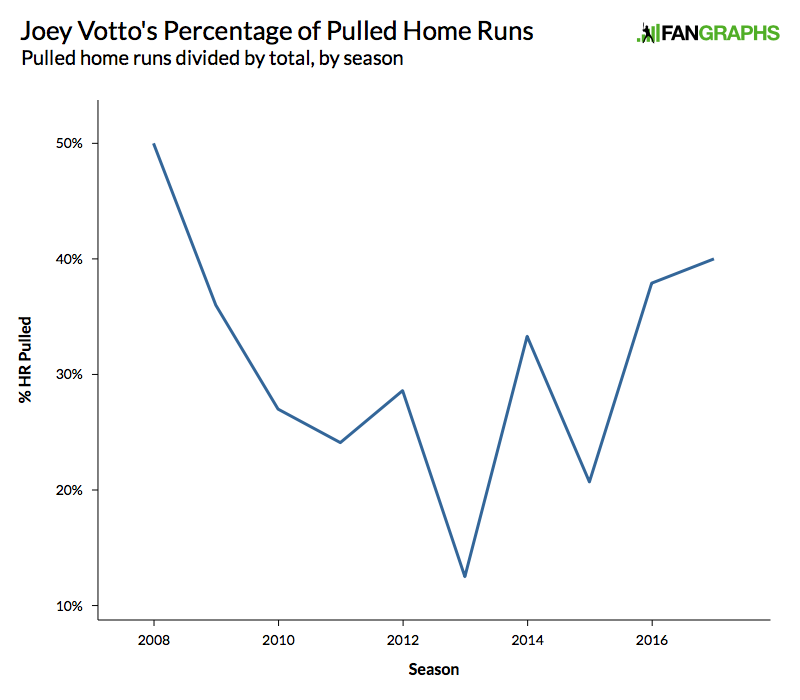Joey Votto and the Changing Strike Zone
Joey Votto hasn’t made a West Coast swing recently so we don’t have original words to annotate here, but he did say some interesting things to Zach Buchanan at The Cincinnati Enquirer this week, interesting particularly because he said that “This has been documented, so this is not anecdotal here,” and that sort of statement is like catnip around here. Let’s provide the documentation.
This is not to say that Buchanan’s piece didn’t do a good enough job. It’s just to say, hey let’s see that evidence that Votto refers to. Because we like graphs and tables here. So here’s what we’re looking at:
The strike zone and pitcher behavior both had changed the last few years, Votto explained at the start of a long, detailed answer that could have doubled as a TED Talk. Before, right-handers would pitch away from left-handed hitters, and lefty swingers would be forced to hit the other way.
Now, the inside strike is being called more often. Pitchers are adjusting and going where the strikes are called. Unfortunately for them, they’re putting it right in Votto’s power alley. (His homer Monday was to the opposite field, on a fastball out and over the plate, but most of his homers have gone to center or right.)
“I can’t think of anything more than that,” Votto said. “I’m going to take what the game gives me. If it goes back to that other way, then you’ll see me hitting balls to left field a little bit more often.”
The first is demonstrably true. We looked at this back in May and if the images then weren’t compelling enough back then, maybe an update on the graph will do the trick. We’re seeing the fewest balls per called strike on the inside third to lefties this decade.

For the precise, they might even like to know that this ratio has regressed backwards from 1.844 earlier in the season to 1.891 now, but the effect is still clear. The lefty zone has shifted back towards the inside.
The next bit I hadn’t actually seen documented, but it makes too much sense to be wrong. Have pitchers begun taking advantage of this? Let’s compare raw percentage of inside pitches to lefties over this time frame.

Of course the graph doesn’t start at zero and that makes the effect look larger. But this is over the course of thousands of pitches. If today’s pitchers were throwing inside at the same rate as they did in 2010, they’d have thrown 3,692 fewer pitches inside to lefties so far this year. So it’s a big deal.
It’s even more pronounced of an effect to Votto himself.

Jonah Pemstein showed that hitters generally pull pitches on the inside and go to the opposite field with pitches on the outside, so the next part should be easy to show as well, but let’s finish off the job, shan’t we? Here’s the percentage of pulled balls by lefties over time.

This effect is muted. “It’s hard as sh*t to hit a ground ball to the other way, it’s science and angles,” Jay Bruce said the other day, “So I believe people are saying ‘f the shift’ because the bunt is defended and going the other way is so hard. The most successful ball is the pulled ball in the air.” And yes, we are seeing the most pulled balls in the air in our sample… 23.8% to 2014’s 23.4%. Not as big of a deal, even over thousands of balls in play.
Maybe not every hitter is doing this, but some are. Even Votto’s pull and pull fly ball rate this season (36.1% and 14.2% respectively) are in line with his career averages (35.1% and 13.1%), though. Take a look at the percentage of his home runs that were pulled, and there might be a little bit of an effect.

Once again, though, this is the tiniest of changes. A homer here or there could change the percentage drastically. So even though the shift is killing the pulled ground ball, and pitchers are pitching inside, batters haven’t yet fully taken advantage of the situation by pulling those inside pitches in the air.
“The numbers, of course, back Votto up,” wrote Buchanan. They do! But in one key area, it’s less conclusive. Then again, it’s one thing to decide that more inside pitches should mean more pulled balls in the air. It’s another thing to do it. “Everything is way harder than just saying it,” Bruce said about adjustments, in an exasperated tone.
Lefties have been taught to cover the outside part of the plate for years, because the strike zone was bigger for them over there. The zone has now shifted to the inside a bit. Let’s give hitters more than a year or two to adjust to it. Hitters other than Joey Votto, maybe.
With a phone full of pictures of pitchers' fingers, strange beers, and his two toddler sons, Eno Sarris can be found at the ballpark or a brewery most days. Read him here, writing about the A's or Giants at The Athletic, or about beer at October. Follow him on Twitter @enosarris if you can handle the sandwiches and inanity.

internet baseball gold. thanks again, Eno.